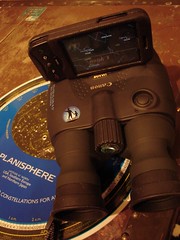
What was the first app I installed on my Android GPhone? Google Sky Map! Could it be one of the reasons why I got the gPhone instead of iPhone? Yes! It's the only one of it's kind that seems to let me "see" through walls to survey the stars from anywhere at anytime.
Google Sky Map almost transforms your Android gPhone into a kind of "Augmented Reality" device. Here's how it works: When you hold or move your phone at any direction, the screen shows the stars, planets, constellations and other celestial objects in that area of the sky. They are correctly labeled for your convenience. It also shows the grid of the Right Ascension (RA) and Declination.
The thing I can share is that ever since I used it, it seems to have expanded my Astronomical Sense of Awareness(tm), well in aspects of orientation at least. Now I can tell you exactly where the Polaris is from my bedroom, or cubicle. Also I can point where the Southern Celestial Pole is even while sitting at my favorite toilet seat! Is this the glimmerings of a heightened sense of awareness?
With continued use, I will soon be able to answer anyone who asks me where Cygnus is, at any time of the day.
Another great thing about it is that it allows me to look at the Southern constellations as well. I point it on the ground of course, and it gives me an eerie feeling that I'm actually floating in space.
Below are some notes that I've compiled regarding it's features.
Zoom.
Great. It resolves some notable Double/Binary Systems.
Search.
Awesome. I'm always looking out for Jupiter, and Cygnus--where Kepler is staring at. You just input the object's name and an arrow will guide you to which direction you should hold your phone. The arrow changes color as you sweep closer to the target, and turns yellow as you "lock-in" on the object.
Sometimes I look like a "pervert spinning around trying to photograph a fly" during my sweeping motions to home in on the target. One time, I didn't realize the object I was searching for happened to be in the direction of another person. So when I finally managed to lock on the target, my gPhone was directly in front of a lady's face. Don't ask me what happened next.
Tip: Do not use the search feature when around other people.
Responsivity.
Fast. Provided you don't run other memory-intensive apps in the background, it is smooth when you sweep across the sky. (But it jitters a bit even when you hold the phone completely still) Tip: Close other apps to maximize performance. Also, turn off the Sky Gradient in the settings to improve responsiveness.
Multi-Tasking/Multi-Threading.
It performs well running in parallel with Twidroid and Twitta. But it sucks with Last.FM. It starts to jiggle wildly.
Accuracy.
Excellent. Stars and Constellations are where they are supposed to be. :) Tip: If you notice a misalignment, wave the phone (using your wrist) in a figure-eight, zen-like manner to re-calibrate, and the constellations will fall into their rightful place!
User Experience.
Excellent. If it overlayed graphics over real image, it would be the ultimate Amateur Astronomer's Augmented Reality system, similar to Wikitude.
The GPS+Compass+Gyroscope sensor combo is a real killer. Google Sky Map managed to leverage that by implementing it to my favorite subject, Astronomy.
Exogazing Use.
This App will be indispensable for Exogazing now that it can show me the Right Ascension (RA) and Declination of the sky. I used to find an exoplanet's location in the sky via constellation, but now i know which part of the sky it is when given the RA/Dec values. The Planetary Society gives this info in their Catalog of exoplanets so I'll be using both in tandem. I just count a few lines on the Declination grid to get an estimate, though.
Other Fun TricksUsing velcro, I attached my Android on top of my binocular and the experience is amazing! While holding the whole contraption sweeping across the sky, after I lock-in on an object using the search feature of Sky Map, I then just simply look through the eyepiece and the object is there! It works swell specially when the zoom, calibration and orientation is perfectly matched between the App and the binocular.
Oh, now i wish my binocular has this graphics overlay directly inside of it's field-of-view!
Feature Requests:
1) Search via Right Ascension (RA) and Declination (Dec). I need to find some objects given the RA and Dec coordinates. Also, it would be great if the Declination were labeled so i didn't have to count lines?!
2) Zoom feature must at least reveal the fainter stars when you zoom in at a closer Field-of-view (FOV).
3) FOV scale. I need an easy way to match my binocular's 4.5 degree FOV with the current zoom setting of Sky Map. Right now I resort to calibrating using two guide stars of the big dipper. It would be awesome if it shows the zoom level in the interface.
4) Satellite tracking/search. I'd like to see Iridium flares on demand. Is that too much to ask?
5) Option to use camera and over-lay graphics on the image in real-time. This would make it truly an Augmented Reality device!
ConclusionOver-all, the Sky Map is a great tool for Astronomy enthusiasts. It's a great learning tool and a wonderful teaching instrument. Now you can do astronomy in broad daylight and see stars and constellations from the other side of the hemisphere.
And yes, it is fun!
 The planet-hunting technique called Astrometry has finally snagged it's first catch -- a Jupiter-like planet called VB 10b, orbiting a small star.
The planet-hunting technique called Astrometry has finally snagged it's first catch -- a Jupiter-like planet called VB 10b, orbiting a small star.




